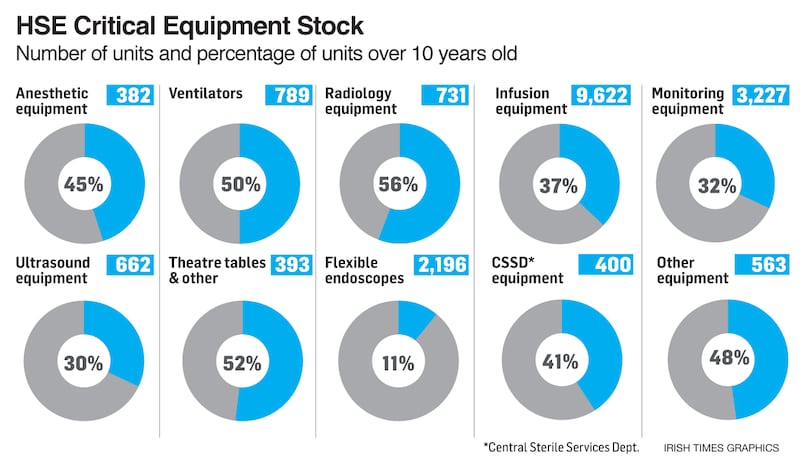Every day staff at the Rotunda hospital in Dublin are carrying out scans or using surgical equipment that has gone past its replacement date.
Frequently technicians are salvaging parts from one machine to keep another in operation as replacement items are not available.
Manufacturers in some instances will not service equipment given its age.

Computers in use in the hospital are in some cases more than 10 years old and work on operating platforms that are no longer supported by Microsoft.
The Rotunda is one of main hospitals in the country for the provision of maternity care and medical services for women.
However, at present it has about €1.1 million of equipment that has officially reached the end of its life and which the hospital believes should be replaced.
In 2016, it sought €650,000 to replace ageing or out-of-date equipment. It received €150,000 or less than a quarter of this amount.
Rotunda master Prof Fergal Malone said that every day equipment is being used in the hospital that is more than a decade old, among them a number of ultrasound machines.
Prof Malone says this can present a risk. If there was shadowing on an ultrasound image because the crystals in the machine have become damaged there is a danger that a foetal abnormality may be missed. “This could have profound consequences,” he says.
Similarly, laparoscopic equipment used for keyhole surgery is also ageing in some cases. Prof Malone warns that if the camera inserted through the belly button of the patient for such a procedure could not provide a clear image, risks are also presented.
The hospital is managing risks effectively but the situation is not ideal, he adds.
The picture presented by Prof Malone at the Rotunda is not unique. In fact, it is replicated in hospitals right across the county.
Last year the Irish Hospital Consultants Association warned of the dangers of what it estimated was a €1.7 billion reduction in hospital capital spending over the last decade or so.
It said: “We are seeing increased problems of obsolete equipment.We have equipment in hospitals that manufacturers will not stand over and where [manufacturers’] guarantees no long apply.
"In Sligo, for example, the only way parts could be secured for intervention radiology equipment was to obtain it from decommissioned machinery in Japan. "
A confidential internal assessment drawn up by the HSE shows there is a backlog of about 9,000 pieces of aged and “at risk” critical equipment.
The HSE has estimated the bill for replacing this equipment would be €322 million.
“These items represent a risk to the HSE’s capability to provide a continuous level of safe care and to provide a high quality service to the Irish population.”
Backlog
At present, the HSE invests about €26 million in equipment replacement annually. It argues that a ramping up of this investment to €65 million a year is urgently required to reduce this backlog over a five-year period and then to focus on reducing the spending gap to €5 million by 2025.
The HSE document says 50 per cent of all patient ventilators in use in the public system are more than 10 years old.
Ventilators are used to provide life supports to critically ill patients in intensive care units, resuscitation rooms or during the transportation of patients within or between hospitals.
It warns that the breakdown of a ventilator would have an immediate impact on the wellbeing of the patient as they would not be receiving the appropriate respiratory therapy, heightening the risk of permanent damage.
“In the event of the machine failing, an immediate replacement needs to be sourced generating a critical risk for the patient and stress for the clinician. Where a replacement is not readily available, respiratory therapy will need to be delivered to the patient manually until a replacement ventilator is located by the hospital.”
The HSE report also says 50 per cent of radiology equipment such as CT or MRI machines used for investigative, diagnostic or interventional procedures are also more than a decade old.
“If radiology equipment breaks down, then the patient procedure cannot be completed and any remaining patient lists are cancelled. Breakdowns have an immediate impact on patient treatment and diagnosis timelines and also lead to unnecessary delays and stress to the patient.
“If the machine is not repaired, then funding for a replacement machine must be secured as a replacement machine is required as soon as possible. Replacement delivery can take up to four months. This results in a delay in patient throughput and an increase in waiting times for non-emergency patients.”
Theatre tables
The HSE document also warns that 52 per cent of theatre tables, which are used to facilitate the correct orientation of patients for surgical procedures, are more than 10 years old.
“In the event of equipment failure during surgery, an alternative has to be immediately sourced or the procedure has to be terminated. This has a negative impact on the patient who was undergoing the procedure as they have to return to the operating theatre when the procedure is re-scheduled, creating unnecessary health risks to the patient.”
The HSE document also warns of dangers posed by breakdowns of infusion devices which are used to administer fluids and to control drugs given to patients in an operating theatre, intensive care unit and emergency and other hospital departments.
“The risk is further heightened by the fact that this equipment is used extensively in operating theatres and intensive care units where any equipment malfunction has an instant deteriorating impact on a patient’s wellbeing. The risk to patient safety is especially high when a malfunction occurs during a procedure or surgery.”









